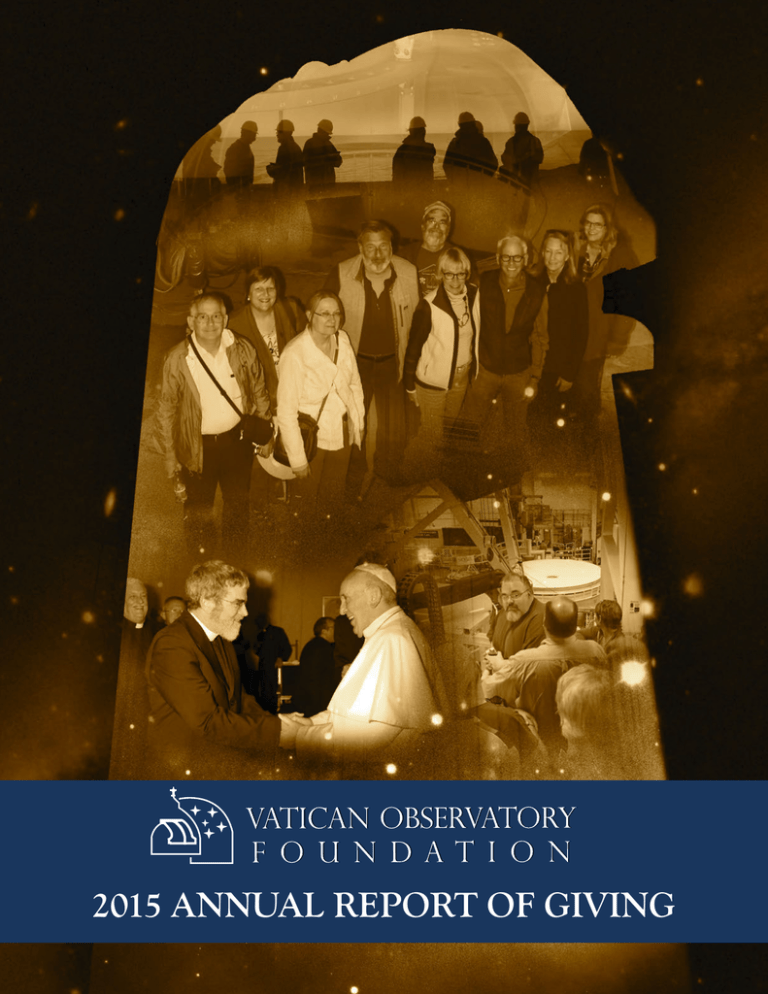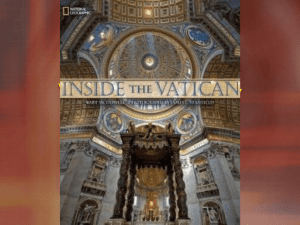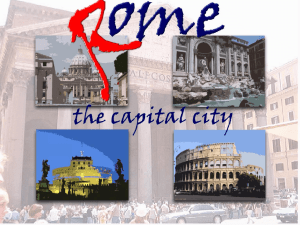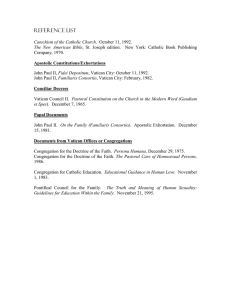2015 Annual Report - Vatican Observatory Foundation
advertisement

2015 ANNUAL REPORT OF GIVING VATICAN OBSERVATORY FOUNDATION Annual Report 2015 Page 3 President’s Report Our Mission Chairman’s Report When Pope Leo XIII founded the Vatican Observatory in 1891, his goal was to show the world that the Church supports good science. The Vatican Observatory Foundation is your response to that mission: you support the Church as it supports good science. The Vatican Observatory has a double-edged As I write this we have just celebrated the feast of Epiphany. As described in the Gospel of Matthew the Magi follow a star that leads them to the Christ child. Pope Benedict XVI, in his book “Jesus of Nazareth: The Infancy Narratives,” states that the Magi were more than just astronomers driven onward by a celestial event. mission: scientific research into the knowledge of the universe, including our place in it, and the education of the public based upon the knowledge derived from that research. These two driving forces of our mission are Good science is the heart of our work. This past year, your contributions have first and foremost allowed Vatican astronomers to spend 80 nights at the Vatican Advanced Technology Telescope; they studied star clusters, near Earth objects, Trojan asteroids, exoplanets, and a survey of stars that look like our sun when it was young. very much intertwined. In 1987, the Vatican Observatory In January, we held our first Faith and Astronomy Workshop. Twenty five parish educators from the US and Mexico had a chance to visit our friends in the local scientific community, to see scientists at work. This included visits to The University of Arizona Mirror Lab, the headquarters of the OSIRIS-REX mission to an asteroid, and a tour of the Planetary Science Institute (with a special exhibit of space art by one of its founders, Bill Hartmann). They also got to see the stars themselves through telescopes set up under the dark desert skies. made possible the creation of the Vatican Advanced In April we took a trip to Chile to see, close up, the telescopes around the Atacama Desert. The highlight was a visit to the Atacama Large Millimeter Array at an elevation of nearly 17,000 feet! students of astronomy from around the world. Our Catholic Astronomer blog is attracting a thousand hits a week. We have given a dozen talks in person or via the internet to high school students across the country. Through the Jesuit Virtual Learning Academy we’ve even taught a regular for-credit high school course on line. And Fr. Rich Boyle generously donated part of an observing run to give two high school astronomy classes time on our Vatican Advanced Technology Telescope (VATT) to image, and process, deep sky objects selected by the students. But note, when I say “we” have done all these things, I really mean that you, the supporters of the Foundation, have done them. Your contributions made them possible; in many cases, your assistance helped make them happen. We all are the Church; we all are supporting, and doing, the science. As St. Paul says in the Letter to the Romans, since the beginning of time God has revealed Himself in the things he has made. When we do astronomy, we’re paying attention to His revelation. Br. Guy Consolmagno President Foundation was established as a tax-exempt corporation The wise men from the east are a new beginning... Not only do they represent the to support this mission. people who have found a way to Christ, they represent the inner aspiration of the RESEARCH. In the early 1990s the marvels of technology and the commitment of a few visionary philanthropists Technology Telescope (VATT), which empowered scientists to look with more acute “eyes” into the universe. Today, the VATT continues to provide stunning access to the heavens for researchers from around the globe. Combined with other technologies and the continued commitment of Vatican Observatory scientists, our work is literally pushing the boundaries of what we know and how we know it. Joining in this research are many EDUCATION. Each year members of the Observatory staff share their expertise by making educational presentations on the average to over 5,000 persons from 90 educational, religious, and academic groups. In recent times Vatican Observatory scientists have played an increasingly important role in the dialogue between science and faith. The Vatican celebrated the 80th Anniversary of the Vatican Observatory in Castel Gandolfo with an 80-cent stamp depicting Pius XI and the summer papal palace where he dedicated the facilities in 1935, and a 95-cent stamp that features Pope Francis with the Moon and the 1957 Schmidt telescope visited by Pope Paul VI during the Apollo 11 landing. human spirit, the dynamism of religion and human reason towards Him. The astronomers of the Vatican Observatory continue this journey as they apply human reason in the search for truth, that is, the search for God. Humanity marveled at the vistas never before seen as the New Horizons robotic probe surveyed Pluto in July 2015. Br. Consolmagno published results on the asteroid Vesta using data from the Dawn robotic probe. Fr. Corbally is using high precision data from the Kepler spacecraft to understand the nature of young stars and pulsating stars, while the data analyzed by Br. Macke is being used to interpret the motions of spacecraft orbiting Mars and the Moon to measure their gravity fields. Fr. Omizzolo extends the quest to nearby clusters of galaxies 500 million light years away where he seeks to understand how gas and stars are stripped away from “Jellyfish galaxies,” so called because they have tentacles of material streaming from the galaxy thus appearing like their namesake. The Vatican Observatory is one of the few institutions where science and religion meet in constructive dialogue. I found myself in awe of the work of the Vatican Observatory when I first learned of the group fifteen years ago. The study of the universe by men of faith is fascinating on multiple levels, and I am honored to help guide the non-profit Vatican Observatory Foundation. The Vatican Observatory Foundation was established in 1987 at the urging of Pope John Paul II in order to fund construction of the Vatican Advanced Technology Telescope to conduct leading edge research as well as to support education. The mission remains the same today and is made all the more relevant in a time when many misleadingly assert that religion and science are incompatible. In my view, the Vatican Observatory Foundation is a fascinating partnership between the Catholic Church, dedicated scientists, and benefactors who welcome the pursuit of knowledge and understand that the Heavens proclaim the Continued on Page 5 Board of Directors Br. Guy Consolmagno, S.J. | President Mr. Richard Friedrich | Chairman Rev. Christopher Corbally, S.J. | Secretary Br. Thomas Williams, S.J. | Treasurer Ms. Karen Dalby Fr. Paul Gabor, S.J. Mr. Roger Gamache Mr. Christopher Hitchcock Ms. Nancy Lebofsky Mr. James McGee Fr. Paul Mueller, S.J. Mrs. Pamela Moore Snyder THANK YOU to our generous benefactors Acadia Festival Bianca L. Acosta Tom and Donna Adams Susan Adamson Michael and Maxine A’Hearn Mr. Steven Aikman Alamo Colleges Roenna Alegre Carlos Altamirano Wayne and Corlin Ambler John S. Anderson Daniel Apai Ar-Hale Family Foundation Vincent and Eileen Baiocchetti Lee Baker James M. and Jean Bannan Jerry and Sheila Bannan John Baross Joseph and Marianne Bassi Elmer and Katherine Batts John Alexander Bauer Judith A. Beck Julie Bedson Anne S. Benninghoff Peter and Willo Benoliel Douglas M. and Elda Bielanski Patrick Anthony Birck Msgr. Colin Bircumshaw Ms. Jean M. Bis Michael Bloom Kevin Booker Lauren Elise Bordelon Boston College Jesuit Community Doris Bourbeau Sean Boyle David Brinegar Ryan Michael Brodeur Alfredo Brogioni William and Marianne Brown Vern Joseph Brownell Neal James Buckon Ruth Marie Burlas Fr. John C. Burnette Mr. Gerold Busch Sr. Joan Callahan James P. Campbell Canadian Catholic Campus Ministry James Cardinal Michael Carlisle Carl L. and Rose Marie Carlsson Pedro Cartaya John Cavanaugh-O’Keefe Thomas Check Paul and Shirley Chorney Ernest J. and Barbara Cismowski Rose C. Collins Fernando Comeron Joseph and Patricia Consolmagno James Cook Asantha Cooray Joanne Cunningham David M. and Mabel KY D’Amore Joanna Dailey Ben and Karen Dalby Daniel and Roseanne Collins Scott Danielson Sam and Ann De Francesco Dennis and Susan De Pietro Sr. Regina Delaney Susan Delonis Nikolay Denev Msgr Anthony Mason Densmore Ms. Patricia M. Derry Gregory M. DeSaye Sabrina Di Matteo Guy and Gisela Di Spigno Sr. Elizabeth Anne DiPippo Msgr. George E. Dobes Bernard P. and Mary H. Doherty Constance D. and Edward T. Donahue Gustaf and Patricia Drews Andrea Dudek Christopher and Pamela Dunn Bethany Louise Ehlmann Ed and Frances Ehrhart Ade Eitner Elephants in the Livingroom Charles Elledge George P. Engeler Thomas J. Fahey John P. P. Fallon Xiaohui Fan Mr. Kevin Anthony Farrell Michael and Janet Feeley Nancy Louise Feeman Michael N. Figueroa Bruce Michael Filak First Friday Club of Greater Arkon Msgr. J. Terrence Fitzgerald Kay Fitzpatrick John W. Flesey Victoria Flower Deacon David and Lorie Ford Sarah Formica Ahmanson Foundation Stephen and Mary Birch Foundation David Franks Roger and Patricia Frey Richard and Debora Friedrich Edward A. and Susan Fuess Bob and Claire Gadbois Fr. John Francis Gagnier Paolo Galaverni Roger and Anne Gamache Gannon University Donald and Maureen Gardner Karen Gardner Michael Garrett Astrid Gasca George and Andrea Goodison William N. Gilmore, Jr. Charlotte Glasser Glenn and Carol Galler Paul Francis Glock John M. Goebelbecker George Goldberg Justin Joseph Golden Paul Gorski Stanton R. Gould Elisabeth Graham Christopher Graney Mr. Russell Jean Gray John and Christopher Graykoski - Songne Robert Greef Fr. James T. Gregory Saul Grijalva Varillas Sheila Grinell and Thomas E. Johnson Toni Bannan Gross Barbara J. Gutt Gary and Debra Gutt Alec and Kimberley Habig Kathleen E. Hallack David Hallowell Pete Hasbrook Suzanne Hayward Harris Msgr. Michael David Hazard Ronald and Ingeborg Henry Mr. Louis Hess John J. Hickey John M. Hill Lauren Hines Michael Hogan Msgr. Martin D. Holley Rev. William Holtzinger Holy Family Regional School Ana M. Holzbach, Ph.D. and Robert Holzbach Fr. Patrick Howell, SJ Ann D, Hungerman James Edward Hunt Robert J. and Paula F. Hurtubise Msgr. Donald J. Hying Gianna Iannucci Nancy Iredale Luis G. Garcia Iturrino Arthur Neyle Sollee IV, M.D. Mary Louise Jackowicz Esther Jang Jeffrey and Amy Remillard Stephen J. Jenkins Jesuit Community of the Vatican Observatory Jesuit Virtual Learning Academy John and Diana Davenport John Curran, Jr. and Andrea Sims Johns Hopkins University Patricia Johnston Randolph Jones Kurt Just Helen Karn Amanda Kelly Michael and Barbara Kelly John C. Kemper William and Jean Keppel King University Hollis and Susan King Ronald and Barbara Knill Nancy J. Knoche Henry and Diana Knoepfle Roxanne Korman William E. Kovacic JoAnne Krolak Daniel Kumar James Riley Kurzynski Charles J. Lada Raymond T. Lamanna Drew Lamkin and Mary Rannestad Alex Lamperti Thomas Lamperti Alan G Landvay May Lane Ronald and Maryam Lane Robert LaPorte Richard Kenneth Larimer Larry and Carole Krucoff Deirdre Lavallee Salvador Lazcano DC Sydney and Gloria Leach Larry and Nancy Lebofsky James Michael Lee Legatus of West LA Legatus-Detroit Chapter Robert P. LeMarr The Fred A. Lennon Charitable Trust Drs. Michael and Stacey Lent Michael and Connie Leschin Edwin and Susanne Lindgren Thomas Lord Charitable Trust Louis Cornelius and Priscilla Boroniec Kenneth L. Lovasik Theresa Loyd Loyola High School Loyola Marymount University Jesuit Community Loyola University Arnis Ludborzs Lumen Catechetical Consultants Jonathan Lunine Joan MacDonnell Jill Maher Michael and Jean Maiuri Philomene Ntumba Makolo Nathan Mamo, S.T.L. Manresa Jesuit Retreat House James J. Marie Gregory Karol Martin Fr. Timothy Martinez Rebecca Anna Martinez Barbara and Ronald Marusiak Christoph Marx Joanne Carol Mawhinney Greg and Linda Maxon Joseph and Karen McCaughey Stuart McHugh Simon and Michelle McIlroy Ms. Margaret Rose McMichael Lawrence and Mary Ann McNamee Mr. Steven McTavish Mr. Henry Mellon Fr. William Menzel Ronald Meyer Kenneth and Karen Miller Montgomery Bell Academy Ronald Paul Monti Sara M. Monti Peter and Tess Moore Jim Morley Ms. Margaret J. Moylan Patricia Mueller Billie Mullen William Joseph Mullin Mary F. Mulvaney Leonard Muni William and Barbara Murphy Musecon Maureen Ann Nadin Craig and Laura Nance Anne Navach John Newman Fr. Tim M. Nondorf, Jr. Edward and Irene Norey Anna O’Brien Jack O’Connell Sharron L. O’Connor Joseph and Martha O’Donnell Edward Luther Oleen Jacqueline Antonia Oliver Mark and Lori Orvek Richard and Sue Orzepowski The Pacific Western Foundation John Palmer Leanne Pavel Robert and Amy Peterson West Pharmaceuticals Alan Phipps Christine A. Pitt Norbert and Katrina Pittner Conrad Plimpton Michael and Marian Plott Mickey and Kaya Pohl Larry Polsky Presentation of Mary, Inc. Raymond J. Preski Mike and Katy Presnell Vincent A. Punzo Daniel and Kristen Quigley Msgr. Francis A. Quinn Dustin Rabideau Radiant Global Logistics, Inc. Reesha Ramoutar Travis E. Rankin Raytheon Tucson Management Club, Inc. Redemptorist Renewal Center Stephen and Sue Reel Bryan T. Reif Michael and Jennifer Reilly Donald and Dorothy Rempe James and Jean Renn Jeanne Rice Bernard L. Richards Roberta Roads Christopher RoDee David L. Roop Kenneth and Micki Rose Miss Abigail J. Ross Joseph Round Ursula Rudolf Rhonda RoJayne Rundle Cliff H. Running David Rusconi Mr. Stephen R. Rusmisel Teresa Rusmisel Richard Ryans Ronald W. Sams Santa Clara Jesuit Community Fr. Timothy James Sauppé Erhard Johannes Schauer Patty A. Schilling Kenneth and Maureen Schmidt Ronald C. Schnatzmeyer Thomas Schneck Fr. Robert John Schrader Fr. Robert Theodore Schriber Robert Jude Schroeder Andrew William Scott Terry Seidler Mr. Frances Serio Sheil Catholic Center Prof. Glenn R. Showalter, M.Ed. Jonathan and Joanna Shubin Barbara M. and Eugene J. Sigillito Sigma XI, The Scientific Research Society Fr. Christopher James Singer David Sirota Byron R. Skinner Joseph and Susan Small Elizabeth Smerak Michael G. Smith Robin and Connie Smith Pamela Moore Snyder Thomas and Margaret Sones Tamara Sonn Mrs. Rosemarie Spedaliere Robert N. Spinelli and Christine A. Crawford St. Francis of Assisi Church St. Ignatius Church St. Joseph’s Catholic Church St. Thomas The Apostle Jacqueline K. Stefko Kenneth Eugene Stevens Fr. William Francis Stolzman Kerry G. Stubbs Woodruff T. Sullivan, III Sylvia A. and Michael Szpak John and Margi Taddeucci Frederick E. and Charlotte L. Tallman Fr. David K. Taylor John Templeton Foundation Ed and Mary Ternan Kathie and Harry Teter The Forum, Inc. The John B. and Nelly Llanos Kilroy Foundation Thomas and Cynthia Rahmlow Thomas Merton Center Brendan and Sandra Thomson Ms. Suzanne Marie Thornberry William H. and Carol A. Tierney Mr. Lyle Bernard Tiffany Michael Timmreck Lisa Tobias Christine Wing Shan Tong Jean M. Trombly Truman State University Gary Turton Dr. Oliver Ullrich Prof Dr Dr Annual Report 2015 University of Detroit Mercy Jesuit Community University of North Carolina, Wilmington University of Notre Dame University Series Foundation, Inc. USA Jesuit Conference Patricia Vanderslice Joseph Varco Gustavo Vargas Y William Vartorella Patricia Vega Christopher Viney Donald J. Voorhies Fr. Wilbur J. Votraw John and Marletta Wagner Msgr. Peter Waslo Michael J. Whitehead Josefina V. Willis Jokie X. Wilson Paul Winkeler Debra Yates Gordon Zaft Leonardo Zambonini Frank Zatko, Ph.D. Felician A. and Jean Zell Fr. Christopher Joseph Zerucha Robert and Graziella Zinn Page 5 Continued from Page 3 Income: $900,148.00 Glory of the Creator. Our Board of Directors is committed to enhancing this community, and I am happy to present these pages to illustrate the important work taking place in the US and throughout the world. Publications and Royalties: 1.5% In 2015 the Vatican Observatory achieved unique milestones in outreach to lovers of wisdom, young and old. Our new foray into social media, The Catholic Astronomer blog, saw five times more daily visitors in December than in February resulting in over 60,000 views for the year. The number of “Likes” on our Facebook page increased 50% to over 2100. Please share this page with your friends and see if we can get 5000 likes in 2016. Additionally, 30% of our donors were new in 2015. We thank you for being a part of this journey and becoming a part of this unique community. On behalf of the Board of Directors, I offer my profound gratitude to all who support the Vatican Observatory Foundation. Your support is paramount to the long-term viability of this vital endeavor. In these pages I hope you find insight, inspiration, and perhaps the same sense of awe I experienced the first time I met these Jesuit scientists over a decade ago. Rich Friedrich Chairman EPO: 6% Grants: 24% Contributions: 68.5% Expenses: $897,656.00 General & Administrative: 7% Depreciation: 10% Fundraising: 15% VATT: 42% On-Going Educational Efforts EPO: 26% The VOF has made every effort to ensure that all information is Income correct. If any errors or omissions are noted, we offer our apologies $600,320 and ask that you notify us. $900,148 Donors $548,650 290 Br. Guy visited his hometown in the fall and spoke at Holy One of our High School Astronomy Program participants: Family Regional School in Rochester Hills, Michigan. The Astronomy Club from Mercy High School in Watertown, CT. 2013 2014 Gifts 488 2015 324 410 2013 2014 2015 Online Gifts 1009 207 548 156 57 2013 Rev. Jose G. Funes, S.J., Director of the Vatican Observatory, Archbishop Carlo Maria Vigano’, Papal Nunzio to the United States, Br. Guy Consolmagno, S.J., President of the Vatican Observatory Foundation, our host Dr. Duilia de Mello, Physics Department, CUA, and Monsignor Mark Morozowich, SEOD, Acting Provost of CUA. 2014 2013 2015 2014 2015 Average Online Gift $134 $232 $291 VATICAN OBSERVATORY FOUNDATION Development Report 2015 brought a few changes to the VOF. Perhaps the most significant was Pope Francis appointing Brother Guy as the next director of the observatory. This means he will be wearing two hats but rest assured that will not stop him from continuing to address groups all over the world telling our story. The VOF outreach programs continued to thrive last year. At the new Faith and Astronomy Workshop parish educators spent 4 days in Tucson learning about astronomy, past and present, and how to share this information in their parish communities. Subscribers to the Catholic Astronomer blog have more than doubled during the past year with some articles reaching over 3000 readers. In 2015 several schools in our High School Astronomy Studies program collaborated with Fr. Richard Boyle using the VATT to create incredible astronomical photos of galaxies. The annual Circles of Giving celebration was held in Tucson among the meteorites of the Drake Building. Dr. Mark Sykes, Director of the Planetary Science Institute, gave an amazing presentation with never before seen photos of Ceres from the NASA Dawn mission. The Annual Seminar a few weeks later in Washington, DC, was hosted by Catholic University in the presence of Archbishop Carlo Maria Vigano’, Papal Nunzio to the United States. The highlight of the year was the spectacular astronomy tour we had of Chile. Dr. Fernando Comeron, an alumnus of one of the first Vatican Observatory Summer Schools and ESO Representative, arranged for an outstanding experience. We visited magnificent telescopes, gazed at the Milky Way on desert mountaintops, cooked breakfast on geysers and we had our own personal oxygen tanks for the trek to ALMA. It was a once in a lifetime experience especially for those of us who were not astronomers. The VATT and the Arizona Robotic Telescope Network The Vatican Advanced Technology Telescope (VATT) or, more properly, the Alice P. Lennon Telescope and the Thomas J. Bannan Astrophysics Facility, is the keystone of Vatican Observatory’s research infrastructure. The telescope’s design was a pathfinder for new technologies. It is built around the very first prototype mirror made by Professor Roger Angel’s team at the University of Arizona in the 1980s using a pioneering new method, called spin casting. It naturally produces parabolic mirrors (as opposed to the traditional block-ground spherical mirrors) with a new set of optical properties. Such “fast optics”, as they are called, successfully tested at VATT, are now the basis of all of the world’s largest telescopes. VATT has allowed us to acquire valuable scientific data over the years but can it still be considered “advanced” in terms of its technology? We have upgraded VATT so that it can be operated remotely from UA campus (VOF Annual Report 2011), and we are now taking it further towards the future, with a general overhaul which will turn it into a fully autonomous unit (VOF Annual Report 2014). Our effort has received generous support from the Papal Foundation as well as grants from the Dan Murphy Foundation and the Hearst Foundation. The work on VATT is carried out by University of Arizona’s Steward Observatory who owns VATT’s primary mirror, and has a 25% stake in VATT’s operation. Steward is robotizing two other telescopes, the 61” Kuiper telescope on Mt Bigelow and the 90” Bok telescope on Kitt Peak. With VATT, they will form the Arizona Robotic Telescope Network (ARTN). Remote operation has opened new possibilities and made VATT more attractive to observers but this comes at an extra cost: to ensure the safety of the equipment, the telescope needs human supervision on site. Fully autonomous operation will eliminate this need. What is more, robotic telescopes open a new realm of observational astronomy. Everything flows, as Heraclitus said, but most astronomical changes are too slow to be perceptible on the timescales of a human lifetime. That is why few observing programs have studied them. Yet, many astrophysical phenomena are fast enough, provided that the astronomer acquires many brief glimpses of the same object separated by cleverly chosen time intervals. Such observing campaigns cover hundreds of objects per night in quick succession. Annual Report 2015 Page 7 Human telescope operators and observers cannot keep up the high cadence of work typical of the nascent field of time-domain astronomy. This is going to be the realm of robots. The second unbeatable advantage of robots is networking. Two global robotic telescope networks are under construction, allowing one to observe a given object continuously, if needed, by identical telescopes strategically distributed longitudinally in both hemispheres. ARTN will be one of the first (if not the first) facility to open another new path to knowledge, synoptic observations. With its three telescopes it will be capable of observing the same object at the same time with three different instruments, e.g., in three different wavelengths or with spectrographs and imagers. This may be the best way to characterize the physical properties of the surfaces of very small (< 100 ft.) and rapidly spinning asteroids as they rapidly fly by the Earth. Last but not least, robotic operation will offer more flexibility to accommodate student work at the telescopes. Traditionally, telescope time was allocated to individual researchers for a whole night. During that single night, an observer did not share the facility with others. Queue scheduling in general, and robotic operation in particular, represents a much better use of the facilities. University of Arizona’s “full-engagement initiative” towards its astronomy majors, involves them in research projects, including observing. The logistics have been difficult because undergraduates, with their other commitments, cannot be required to spend entire nights at the telescope. Under the old time allocation system, the facility is blocked for the whole night even though students use it only for a portion of that night. Robotic observing can also facilitate other educational and public engagement programs, notably with high schools and amateur groups where the time factor is an even greater constraint. We are confident that by 2017, VATT and the ARTN will once again be at the forefront of astronomical technology, offering new research opportunities, as well as new ways to educate and engage the public in astronomy and science. The technological advances being implemented at the VATT and the collaboration with the University of Arizona in the Arizona Robotic Telescope Network will assure years of excellent scientific research. None of this would be possible without the generosity of our friends. With so many individuals and foundations believing in our mission 2015 was a great year and with the advances on the telescope and the outreach programs the Vatican Observatory Foundation‘s future looks very bright. Thank you! Katie Bannan Steinke Development Director The Kuiper Telescope atop Mt. Bigelow. The Bok Telescope atop Kitt Peak. Paul Gabor, S.J., Ph.D. Vice Director, Vatican Observatory The Kuiper Telescope at sunrise. Non Pro VATICAN OBSERVATORY F O U N D A T I O N NON PROFIT ORG U.S POSTAGE PAID TUCSON, AZ PERMIT NO. 3341 2017 East Lee Street Tucson, Arizona 85719 OR Sample 5 RETURN SERVICE REQUESTED Indicia Design, Placement, and Content Follow the Vatican Observatory on Twitter @VaticanObserv 6.3.1 Production Embossed or unembossed permit imprint indicia may be made by printing Like the Vatican Observatory Foundation on Facebook plate, or similar device. They may not be typewritten or hand-drawn. [P040 6.3.2 Permit Imprint Indicia Content and Format Check out the Catholic Astronomer Blog: www.vofoundation.org/blog The content and format of a permit imprint indicia must meet the standard 6.3.3 Indicia Legibility and Color The permit imprint indicia must be legible and of a color that contrasts suf different color may be used to highlight the background of an indicia. [P04 6.3.4 Indicia Placement on Mailpiece Permit imprint indicia must be aligned parallel with the address of the mai participant code, delivery point barcode) if such a standard applies and ca a. Upper right corner of the mailpiece. b. Upper right corner of the address area. c. To the right of the address on an address label. INSIDE Annual Report 2015 d. To the right of the address on an insert appearing through a window excelling in faith, education, and research The McCarthy-Stoeger Scholarship Awarded to Juan Nicolas Garavito Camargo 2014 Vatican Observatory Summer School (VOSS) student, Nico Garavito Camargo, was recently awarded the new scholarship that honors two late Vatican Photo by Frank Gacon Observatory astronomers who continue to be sorely missed, Fr. Martin McCarthy, S.J., and Fr. Bill Stoeger, S.J. From his home country of Colombia Nico has moved to Tucson starting to work towards his graduate degree at Steward Observatory. His field of interest is Galaxy Formation and Evolution Theory. The scholarship is awarded by the Vatican Observatory and sponsored by the Jesuit Community in Tucson and Castel Gandolfo. Nico at Bogota’s Planetarium SpaceArt project building “exoplanets” with the children from the area’s barrio.




